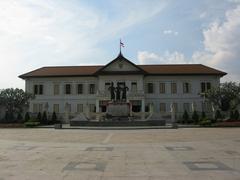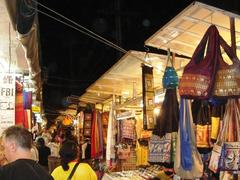Wat Phra That Doi Suthep: Visiting Hours, Tickets, and In-Depth Guide to Chiang Mai’s Iconic Historical Site
Date: 14/06/2025
Introduction
Wat Phra That Doi Suthep, perched atop the 1,676-meter-high Doi Suthep mountain, is one of Chiang Mai’s most iconic and spiritually significant landmarks. Dating back to 1383 CE, it offers visitors a unique blend of historical depth, legendary origins, artistic grandeur, and sweeping panoramic views. The temple is revered for its enshrinement of a sacred Buddha relic, its storied white elephant legend, and its role as a spiritual and cultural heart of Northern Thailand. This comprehensive guide provides essential information about visiting hours, tickets, accessibility, travel tips, and the temple’s historical and cultural context, ensuring you make the most of your visit to this remarkable site (Agoda Guide, Thailand For Visitors, Tripoto).
Historical Background and Cultural Significance
Origins and the Legend of the White Elephant
Wat Phra That Doi Suthep’s origins are deeply rooted in both history and legend. Established during the Lanna Kingdom under King Kuena, the temple’s location was chosen following a miraculous journey. A monk named Sumanathera discovered a relic, believed to be a piece of the Buddha’s shoulder bone, which was placed on the back of a white elephant. The elephant climbed Doi Suthep, trumpeted three times, and died at the summit—a sign interpreted as divine, prompting the founding of the temple at that very spot (Tripoto).
Architectural Evolution and Artistic Heritage
From its humble beginnings as a simple chedi, the temple complex has expanded over centuries, incorporating Lanna, Thai, and even Hindu artistic influences. The centerpiece is the gleaming golden chedi, surrounded by intricately decorated shrines, statues, and murals that depict Buddhist stories and local folklore. The famous naga staircase, with over 300 steps flanked by serpent balustrades, is a masterpiece of Lanna craftsmanship and symbolic of spiritual ascent (Agoda Guide, Thailand For Visitors).
Religious and Cultural Importance
Wat Phra That Doi Suthep is one of Thailand’s most sacred Buddhist sites, classified as a “Royal Temple of the Second Class.” It is a major pilgrimage destination, especially during Visakha Bucha and other Buddhist festivals, when local and international devotees ascend the mountain to pay their respects. The relic housed within the chedi is believed to bring blessings and protection to Chiang Mai and its people.
Traditions such as circumambulating the chedi, offering flowers, incense, and candles, and ringing temple bells are all integral to the merit-making rituals practiced here. The temple also plays a vital role in maintaining Lanna cultural identity, hosting festivals and rituals that reinforce regional heritage (Tripoto).
Practical Visitor Information
Visiting Hours
- Temple Complex: Open 24 hours daily; ideal for sunrise or evening visits (GoToThailand).
- Inner Sanctuary (Golden Chedi area): Open from 6:30 AM to 6:30 PM.
- Recommended visit: Early mornings (before 8:00 AM) or late afternoons (after 5:00 PM) for a tranquil experience and cooler weather.
Ticket Information
- Admission Fee: 50 THB for foreign visitors (under $1.50 USD); free for Thai nationals (GoToThailand, BudgetYourTrip).
- Where to buy: Tickets are available at the entrance kiosk—no advance booking necessary.
How to Get There
- Distance: Approximately 15 km from Chiang Mai’s city center.
- By Songthaew (Red Truck): Shared rides from Chiang Mai Zoo or the old city; 40–60 THB per person.
- By Taxi/Private Car: Convenient round trips start at 400–600 THB.
- By Motorbike: Rentals from 200 THB/day for independent travelers.
- By Hiking: Adventurous route from the mountain base, taking 2–3 hours.
Accessibility
- Staircase: The naga staircase has 306–309 steps.
- Cable Car/Elevator: Available for 20 THB, offering an easy alternative for those with limited mobility (GoToThailand, The Thaiger).
- Facilities: Ramps and resting areas are present, but some areas may still be challenging for wheelchairs.
Highlights and On-Site Experience
Architectural Features
- Golden Chedi: The central stupa, standing 24 meters tall, is covered in gold and houses the Buddha relic (Bangkok Air).
- Naga Staircase: Intricately carved serpent balustrades line the main staircase, symbolizing protection and ascent (The Thaiger).
- Viharn and Ubosot: The assembly and ordination halls showcase Lanna architecture, ornate wood carvings, and murals depicting the Buddha’s life (Explore Siam).
- Murals and Statuary: Vibrant artwork and Buddha images enrich the spiritual atmosphere, while guardian figures and mythical creatures add to the temple’s allure.
- Mandala Layout: The temple’s design reflects Buddhist cosmology, guiding visitors from the earthly realm to enlightenment at the chedi (Explore Siam).
Rituals and Visitor Activities
- Circumambulation: Pilgrims walk clockwise around the chedi, making offerings for merit.
- Ringing Bells: Visitors may ring bells along the perimeter for good luck.
- Monk Blessings: Monks offer blessings to visitors; a small donation is appreciated.
- Photography: Allowed in most areas, but always be respectful—avoid flash inside shrines.
Dress Code and Etiquette
- Dress modestly: Cover shoulders and knees; no shorts or sleeveless tops.
- Remove shoes: Before entering the inner sanctuary.
- Behavior: Remain quiet, avoid pointing feet at Buddha images, and show respect during rituals.
Special Events
- Major Festivals: Visakha Bucha, Makha Bucha, and Loy Krathong feature candlelit processions and communal prayers.
- Guided Tours: Available on-site or through tour operators, providing deeper insight into temple history and Buddhist philosophy.
Nearby Attractions
- Bhubing Palace: The royal winter residence with beautiful gardens.
- Doi Pui Hmong Village: A hill tribe community offering cultural insights and traditional crafts.
- Doi Suthep-Pui National Park: Nature trails, waterfalls, and scenic viewpoints.
- Chiang Mai Zoo: Family-friendly attraction at the base of the mountain.
Travel Tips
- Best Times to Visit: Early mornings and late afternoons for fewer crowds and magical lighting.
- What to Bring: Comfortable, easy-to-remove shoes; modest clothing; water; camera.
- Facilities: Restrooms and snack/souvenir shops near the entrance; ample parking at the base.
- Weather: Bring a light jacket for cooler mornings or evenings, especially between November and February.
FAQs
Q: What are the visiting hours of Wat Phra That Doi Suthep?
A: The temple complex is open 24 hours, with the inner sanctuary accessible from 6:30 AM to 6:30 PM.
Q: How much is the entrance fee?
A: 50 THB for foreign visitors; free for Thai nationals.
Q: Is the temple wheelchair accessible?
A: The cable car makes access easier, but some areas may be challenging for wheelchairs.
Q: Are guided tours available?
A: Yes, both on-site and through local operators.
Q: What should I wear?
A: Modest clothing that covers shoulders and knees; sarongs are available for rent at the entrance.
Q: When is the best time to visit?
A: Early mornings before 8:00 AM or evenings after 5:00 PM for a peaceful experience.
Visitor Experiences
Many visitors praise Wat Phra That Doi Suthep for its spiritual ambiance, artistic splendor, and captivating mountain views. The naga staircase is often considered an essential part of the pilgrimage, and the panoramic terrace is a favorite spot for photography. Couples, solo travelers, and families alike find the site enriching and memorable (BudgetYourTrip).
Summary and Final Tips
Wat Phra That Doi Suthep remains an essential destination for anyone exploring Chiang Mai. It represents a seamless blend of spiritual reverence, cultural heritage, and natural splendor. With its sacred relic, legendary origin story, and grand architectural features, the temple offers visitors both a glimpse into Northern Thailand’s past and a meaningful spiritual experience. Plan ahead for the best visiting times, be mindful of dress code and etiquette, and explore nearby attractions for a fuller cultural journey. Download the Audiala app or consult official tourism platforms for up-to-date information and personalized travel tips (GoToThailand, BudgetYourTrip).
References and Further Reading
- Exploring Doi Suthep: A Comprehensive Travel Guide to Chiang Mai’s Iconic Mountain Temple, 2024, Agoda Guide (Agoda Guide)
- Wat Phra That Doi Suthep, Northern Thailand’s Spiritual Landmark, 2024, Thailand For Visitors (Thailand For Visitors)
- Doi Suthep Temple: History, Culture & Visiting Tips, 2024, Tripoto (Tripoto)
- Wat Phra That Doi Suthep – Temple Guide & Visitor Information, 2024, GoToThailand (GoToThailand)
- Wat Phra That Doi Suthep Worth Visiting?, 2024, BudgetYourTrip (BudgetYourTrip)
- Travel to Wat Phra That Doi Sutehp in Chiang Mai, 2024, The Thaiger (The Thaiger)
- Wat Phra That Doi Suthep – A Temple Rich in History and Culture, 2024, Chiang Mai Traveller (Chiang Mai Traveller)
- Wat Phra That Doi Suthep – Temple Overview, 2024, Wikipedia (Wikipedia)
- Additional details from: The Backpacking Family, Bangkok Air, Heritasian, Explore Siam, Trip.com
Image suggestions: Feature high-quality photos of the golden chedi, naga staircase, panoramic mountain views, and ritual scenes. Use alt tags such as “Golden chedi of Wat Phra That Doi Suthep, Chiang Mai” and “Naga staircase to temple entrance.”
For more guides on Chiang Mai’s historical sites and travel tips, explore our related articles, and download the Audiala app for personalized recommendations and interactive maps.

